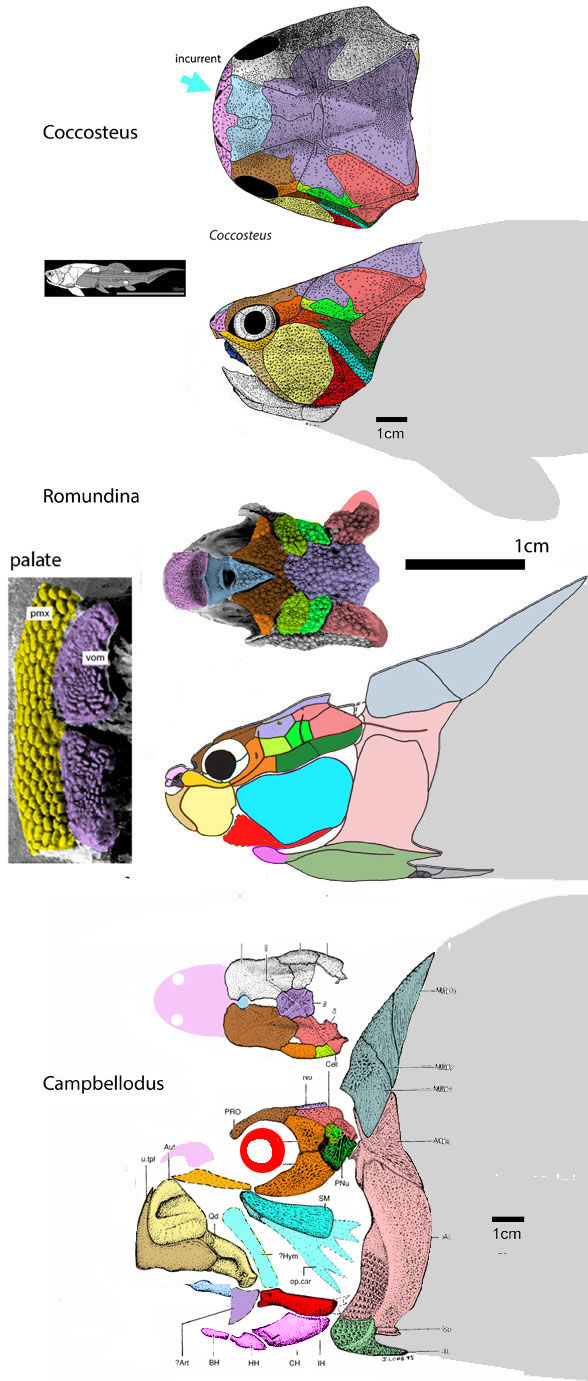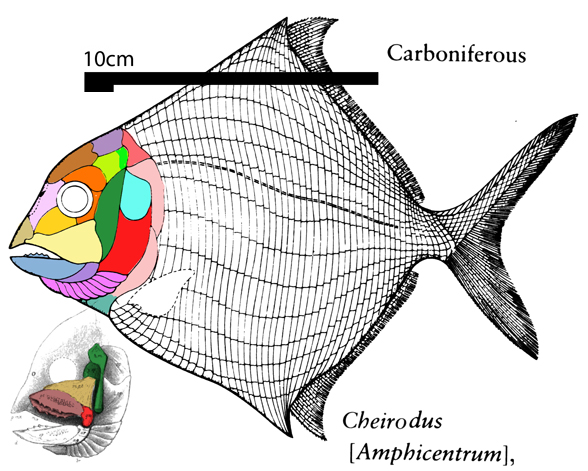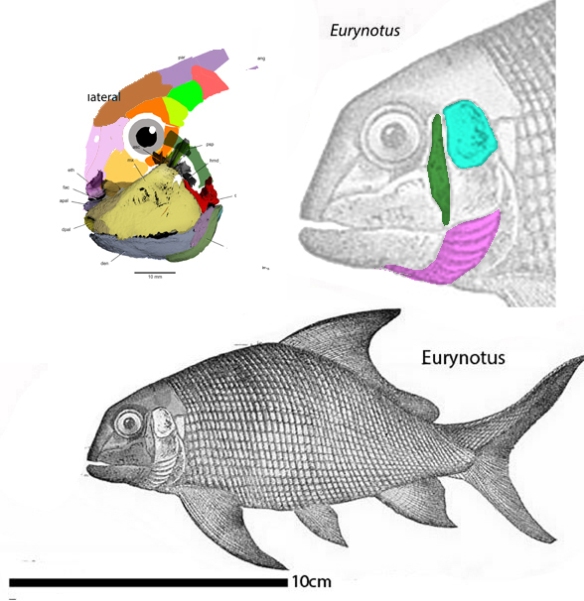Updated November 23, 2023
with new DGS skull colors.
This solves a phylogenetic problem.
These four fish were misfits among the bony fish clade (Osteichthys). By relabeling the skull bones according to placoderm homologies (Fig 1) the problem is resolved.

In ptyctodontid placoderms
the tiny frontal (blue) disappearing in Coccosteus (Fig 1) is replaced by expanded prefrontals (brown). The intertemporal (yellow green), the anchor for the hyomandibular (dark green), touches the orbit in Coccosteus, then lines the orbit in descendant taxa, starting with Romundina (Fig 1).
Mislabeling facial bones (Fig 2) was the issue in prior studies and publications.
As in other ptycodontid placoderms
these taxa lack marginal teeth because they lack a premaxilla and maxilla. The 3-part postorbital enlarges to become the lateral oral margin. The nasals enlarge to become the anterior oral margin.

As in other ptycodontid placoderms
the preoperculum, operculum and branchials are not yet present as they are in bony fish. Instead the expanded jugal (cyan blue) create a posterior margin for the skull, likely covering the gills in a convergent manner.

These four taxa are late survivors found
in Carboniferous, Permian and Triassic strata. Traditional thinking posits an extinction for all placoderms at the end of the Devonian. These taxa were not recognized as placoderms until today.
Housekeeping
in the large reptile tree (LRT, 2295 taxa, subset Fig 6) moves Cheirodus, Bobasatrania, Eurynotus and Platysomus with the ptycodontid placoderm, Campbellodus (Fig 1)

Eurynotus crenatus (Agassiz 1835; Friedman et al. 2018; Early Carboniferous, 310 mya) is widely considered a relative of Cheirodus.
Amphicentrum granulosus = Cheirodus granulosus (McCoy 1848, 1855 20cm; Carboniferous) is a disc-shaped fish lacking pelvic fins, covered in large rectangular ganoid scales. The postparietals are absent. The intertemporal rims the posterior orbit. The jugal is convergent with the operculum. The pelvic fins are missing. Teeth are absent from the upper jaws. Note the heterocercal tail.
Bobasatrania canadensis (White 1932; Permian–Triassic, 255–237mya) This discoidal fish from Madagascar nests with Cheirodus in the LRT. It is the latest known placoderm.
Platysomus parvulus (Agassiz 1843, Carboniferous Cheirodus to Permian; 18cm long) is a taller, more disc-like fish transitional from Campbellodus and. Note the reduction of the mandible. Probably a plankton eater.
This appears to be a novel hypothesis of interrelationships.
If not, please provide a citation so I can promote it here.
References
Agassiz JLR 1835. On the fossil fishes of Scotland. Report of the British Association for the Advancement of Science, British Association for the Advancement of Science, Edinburgh.
Burrow C, den Blaawen J, Newman M and Davidson R 2016. The diplacanthid fishes (Acanthodii, Diplacanthiformes, Diplacanthidae) from the Middle Devonian of Scotland. Palaeontologia Electronica 19.1.10A
Friedman M, Pierce SE, Coates M and Giles S 2018. Feeding structures in the ray-finned fish Eurynotus crenatus (Actinopterygii: Eurynotiformes) implicationsfor trophic diversification among Carboniferous actiniopterygians. Earth and Environmental Science Transactions of the Royal Society of Edinburgh, 109, 33–47.
McCoy F 1855. A synopsis of the classification of the British Palaeozoic rocks, with a systematic description of the British Palaeozoic fossils. Fasciculus 3, Mollusca and Palaeozoic fishes. British Palaeozoic Fossils, Part II. Palaeontology 407-666.
wiki/Cheirodus
wiki/Platysomus
wiki/Eurynotus – not yet posted
wiki/Bobasatrania



